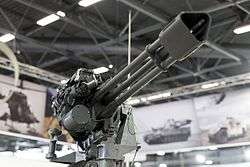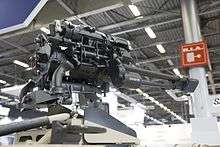GAU-19
| GAU-19/A | |
|---|---|
 | |
| Type | Heavy machine gun |
| Place of origin | United States |
| Service history | |
| Used by | See History |
| Production history | |
| Designer | General Electric |
| Manufacturer | General Dynamics |
| Produced | GAU-19/A: 1983–present GAU-19/B: 2012-present |
| Variants | 3-barrel or 6-barrel |
| Specifications | |
| Weight | GAU-19/A:138 lbs. (63kg) GAU-19/B:106 lbs. (48kg) |
| Length | 53.9 in. (1,369 mm) |
| Barrel length | 36 in. (914 mm) |
| Width | 13.5 in. (343 mm) |
| Height | 15 in. (381 mm) |
|
| |
| Cartridge | .50 BMG (12.7×99mm NATO) |
| Barrels | 3 |
| Action | Electric |
| Rate of fire | 1,000, 1,300 or 2,000 rounds per minute |
| Muzzle velocity | 2,910 fps (887 m/s) |
| Effective firing range | 1,800 m |
| Maximum firing range | 6,000 m |
| Feed system | linkless or M9 linked belt |
The GAU-19/A (GECAL 50), is an electrically-driven Gatling gun that fires the .50 BMG (12.7×99mm) cartridge.
Technical specifications
The GAU-19/A is designed to accept standard NATO .50 caliber M9-linked ammunition. The rate of fire is selectable to be either 1,000 or 2,000 rounds per minute. The Humvee armament kit version fires at 1,300 rounds per minute. The average recoil force when firing is 1.7kN, 2.2kN or 2.8kN depending on firing rate. In January 2012, General Dynamics announced they would be delivering a new version designated GAU-19/B. It provides the same firepower in a lighter platform, weighing 48 kg (106lbs) and optimized for 1,300 shots per minute and an average recoil force of 2.5kN.[1] Both variants can be configured for an ammunition capacity of 500-1,200 rounds. Both variants are reliable to 40,000 mean rounds between failure.
History

The GECAL 50 was first manufactured by General Electric, then by Lockheed Martin, and now by General Dynamics. Design work began in 1982. Early prototypes had six barrels, but a three-barreled configuration is now standard. The GAU-19/A was originally designed as a larger, more potent version of the M134 Minigun. Due to the loss of nine helicopters in Grenada, GE started building prototypes of the weapon in both a three-barreled and a six-barreled configuration. The six-barreled version was designed to fire 4,000 rounds per minute, and could be adapted to fire up to 8,000 rounds per minute. The GAU-19 takes 0.4 seconds to reach maximum firing rate.[2] Soon it was recommended as a potential armament for the V-22 Osprey.[3] The magazine would be located underneath the cabin floor and could be reloaded in-flight. However, plans to mount the gun were later dropped.[4] In December 1992 the US Navy issued a letter of qualification for GAU-19/A integration and use on naval aircraft. In 2005, the GAU-19/A was approved to be mounted on the OH-58D Kiowa helicopter. It also could have been used on the Army's now cancelled ARH-70.[5]
In October 2010 General Dynamics began developing the lighter weight GAU-19/B in response to an urgent needs statement issued by the Armed Scout Helicopter Program Office. By April 2011 flight testing had begun and by January 2012, the U.S. Army ordered 30 GAU-19/B versions for use on helicopters. All were delivered by the next month.[1] In August 2012 the GAU-19/B received a safety confirmation from the US Army Evaluation Center for use on the OH-58D Kiowa Warrior.
Both GAU-19 variants have been integrated on naval vessels (tripod and remote weapons station), vehicles (turret and remotely operated), and on both rotary and fixed wing aircraft (externally mounted under wing fixed forward and man fired from the aircraft door or cargo ramp. Most recently a self-contained gun pod was developed by Fulcrum Concepts LLC [6]
In 1999, the United States sent 28 GAU-19s to Colombia.[7] Oman is known to use the GAU-19/A mounted on their HMMWVs. The Mexican Navy uses MDH MD-902 series helicopters with the GAU-19/A system mounted for anti-narcotics operations.[8]
Users









See also
Notes
- 1 2 GD delivers GAU-19/B - General Dynamics
- ↑ "GAU-19/A (GECAL 50) 12.7 mm Gun (United States), Guns - Integral and mounted". Jane's Air-Launched Weapons. Jane's Information Group. 21 January 2008. Archived from the original on 23 March 2009. Retrieved 29 March 2011.
- ↑ "General Dynamics Selected to Develop Turreted Gun System for V-22 Aircraft" (Press release). General Dynamics Armament and Technical Products. 7 September 2000. Archived from the original on 17 July 2011. Retrieved 29 March 2011.
- ↑ Thompson, Mark (26 September 2007). "V-22 Osprey: A Flying Shame". Time. Retrieved 29 March 2011.
- ↑ "ARMY AIRCRAFT". Committee Reports - 108th Congress (2003–2004) - Senate Report 108-260. Library of Congress. 11 May 2004. Retrieved 29 March 2011.
- ↑ https://fulcrumconceptsllc.com/wp-content/uploads/2017/01/PFS_gp-19_06.pdf
- ↑ "Memorandum for Correspondents No. 176-M" (Press release). United States Department of Defense. 10 November 1999. Archived from the original on 8 June 2011. Retrieved 29 March 2011.
- ↑ Fricker, John (2002). "Region's Military Seeks to Modernize . . . But Tight Funding Forces Ingenuity". Aviation Week & Space Technology. Retrieved 29 March 2011.
References
- Gander, Terry J. (ed.). Jane's Infantry Weapons 1997–98 (23rd ed.). Coulsdon, UK: Jane's Information Group. p. 298. ISBN 0-7106-1548-5.
- "General Dynamics Fact Sheet" (PDF). (401 KB)tfdufetgder34564